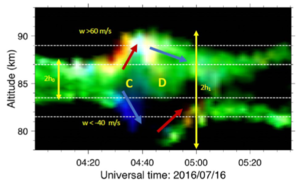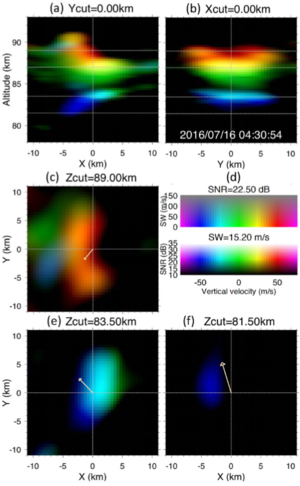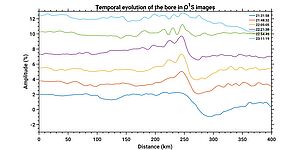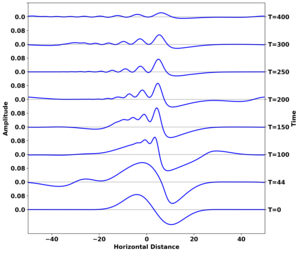- Research Topics
- Department Optical and Rocket Soundings
- Department Radar Remote Sensing
- Department Modelling of Atmospheric Processes
- Working Group Satellite Data Analysis
- Cross-departmental Collaborations
- Projects
- Publications
Mesospheric instabilities
The mesosphere is a highly variable atmospheric region driven by a variety of physical processes driven by waves and turbulence. Gravity waves (GWs) are widely recognized to play a major role in atmospheric dynamics from their sources at lower altitudes into the lower thermosphere. They interact strongly with their environment and other waves, causing dissipation throughout the atmosphere. The majority of GW dissipation and breaking is accompanied by small-scale instabilities and turbulence. Most of these instabilities are associated to local GW breaking, mesospheric bores, and Kelvin-Helmholtz instabilities (KHI).
At the Radar Remote Sensing (RRS) department, we are investigating kilometre-scale instabilities with the help of MAARSY's radar imaging capabilities using Polar Summer Mesospheric Echoes (PMSE) echoes as tracers and complementing the observations with numerical simulations. These investigations have been motivated by recent radar observations of extremely large vertical updrafts and downdrafts lasting a few minutes at 86km that was recently published by Chau et al. (2021). This was a highly localized event, both spatially and temporally, with vertical drafts more than three times the standard deviation. In general, vertical velocities are much smaller than horizontal velocities but they still have a significant effect on atmospheric dynamics, composition, and mixing. With several ground-based remote sensing and in-situ measurements, vertical wind velocity variations of +-5 m/s are commonly observed. Some of this variability can be attributed to instabilities, like KHI and bores. Nevertheless, the drivers of the majority of these instabilities are not completely understood.
To investigate the structure of the observed event more in detail, the newly developed Multiple-Input-Multiple-Output (MIMO) radar imaging approach is used, making the observation of the event in four dimensions possible. From this 4D imaging, one can see the horizontal spatial extent of 3-4 km along x-axis and at least 8-12 km along y-axis (See Fig:1).

The morphology of the observed event resembles a solitary wave or an undular bore in varicose mode (the upper and lower boundaries are 180 degrees out of phase with the one another). The vertical dimensions of our event are much larger than what has been previously reported in mesospheric bore literature, with h0 and h1 being 2.5 km and 6 km, where h0 and h1 are the undisturbed fluid height and bore height respectively. Using the expected temperature and pressure profiles from models as well as the observing the vertical drafts, we find that the ice particle radius is affected by the updrafts (increase in the particle radius) and downdrafts (reduction in the particle radius). (See Fig:2).
While such events are seldom reported from RADAR observations, a plethora of literature exists concerning the observation of undular bores from airglow observations. Complementing our RADAR observations, at RRS we also make use of our airglow imagers to investigate potential kilometre-scale instabilities. One such observation of a bright wavefront event in the night-time mesosphere was observed on 16th of March 2021 in our all-sky imager at Kühlungsborn. This event was characterized by a sharp onset of a wavefront followed by 4-5 trailing waves. The background conditions obtained from the temperature and winds indicate that the event was due to undular bore at 97km. The temporal evolution plot shows the formation of the wave front at an earlier time and slowly steepening over time with more trailing waves being formed. (See Fig:3)
The dynamic processes that lead to the formation of mesospheric bores involve the presence of mesospheric temperature inversion layer (MIL) that acts as a duct or channel in the atmosphere along which gravity waves can propagate. These MILs are often are often seen in the Lidar data. But not all the inversion layers lead to the formation of mesospheric bores. The approach to understand the formation of such mesospheric bores is carried out by numerical simulations. Direct numerical simulations (DNS) suggest the occurrence of such events under certain estimates of Froude number and moderate horizontal wind shears. In many cases, the atmosphere can be considered as being nearly incompressible allowing for the investigation of its dynamics by means of DNS of Navier-Stokes equations in Boussinesq approximation. The initialization of our DNS is done with realistic initial conditions under different background conditions like variable wind- and stability profile. (See Fig:4)
Our current poor knowledge on these extreme drafts (formation, occurrence rate, duration, and predict-ability) as well as limited observing capabilities in the mesosphere, should not impede the exploration of impacts on other fields where kilometre-scale perturbations and instabilities might be important. If they occur frequently, a better understanding and characterization would contribute to the roles of kilometre-scale dynamics in a number of parameters requiring their parameterization in large-scale general circulation weather and climate models. Further observations as well as theory and modelling efforts are still needed to find and identify the specific sources of such kilometre-scale instabilities.
A video describing preliminary results can be found here (external link to youtube).















